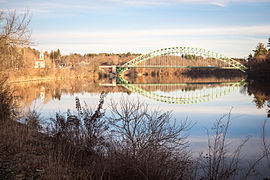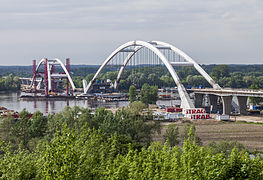Tied-arch bridge

A tied-arch bridge is an arch bridge in which the outward-directed horizontal forces of the arch, or top chord, are borne as tension by the bottom chord (either tie-rods or the deck itself), rather than by the ground or the bridge foundations.
Thrusts downward on such a bridge's deck are translated, as tension, by vertical ties of the deck to the curved top chord, tending to flatten it and thereby to push its tips outward into the abutments, like other arch bridges. However, in a tied-arch or bowstring bridge, these movements are restrained not by the abutments but by the bottom chord, which ties these tips together, taking the thrusts as tension, rather like the string of a bow that is being flattened. Therefore, the design is often called a bowstring-arch or bowstring-girder bridge.[1][2]
The elimination of horizontal forces at the abutments allows tied-arch bridges to be constructed with less robust foundations; thus they can be situated atop elevated piers or in areas of unstable soil.[3] In addition, since they do not depend on horizontal compression forces for their integrity, tied-arch bridges can be prefabricated offsite, and subsequently floated, hauled or lifted into place. Notable bridges of this type include the Fremont Bridge in Portland, Oregon as well as the first "computer designed" bridge of this type the Fort Pitt Bridge in Pittsburgh, Pennsylvania.[4]
A bowstring truss bridge is similar in appearance to a tied-arch; however, the bowstring truss behaves as truss, not an arch. The visual distinction is a tied-arch bridge will not have substantial diagonal members between the vertical members.
Both the tied-arch bridge and the self-anchored suspension bridge place only vertical loads on the anchorage, and so are suitable where large horizontal forces are difficult to anchor.
Issues
In a 1978 advisory issued by the Federal Highway Administration (FHWA), the FHWA noted that tied-arch bridges are susceptible to problems caused by poor welds at the connection between the arch rib and the tie girders, and at the connection between the arch and vertical ties. In addition, problems with electroslag welds, while not isolated to tied-arch bridges, resulted in costly, time-consuming and inconveniencing repairs. The structure as a whole was described as nonredundant; failure of either of the two tie girders would result in failure of the entire structure.[5]
References
- ^ See, e.g., U.S. Patent 14,313 (February 26, 1856) issued to P.C. Guiou of Cincinnati, Ohio, for a Truss Bridge, titled on specification as "Girder for Bridges."
- ^ For a description of how bowstring arch and bowstring girder bridges are related, see Margot Gayle & Carol Gayle, Cast-iron Architecture in America: The Significance of James Bogardus, pages 28-29 (W. W. Norton & Company 1998).
- ^ For a nontechnical exposition, see Gordon, JE (1978). Structures; or Why Things Don't Fall Down. London: Penguin Books. p. 208f. ISBN 978-0-306-40025-4. OCLC 4004565.
- ^ "Pittsburgh's bridge". Travel Channel. Retrieved June 14, 2016.
- ^ Federal Highway Administration (1978-09-28). "TIED ARCH BRIDGES: T 5140.4". Retrieved 2008-07-22.
Gallery of tied-arch bridges
-
The new Lowry Avenue Bridge in Minneapolis, Minnesota carries Lowry Avenue over the Mississippi River. -
The Hoan Bridge is a tied-arch bridge, carrying Interstate 794 over the Milwaukee River in Milwaukee, Wisconsin. -
The Tyngsborough Bridge is the longest and second oldest bridge of this type in Massachusetts. -
The Fort Pitt Bridge is a tied-arch bridge. Note that the arches terminate atop slender raised piers, which provide no squeezing force; tension in the road deck holds up the arch. -
Torikai ohasi (Torikai big bridge) 鳥飼大橋 - over the Yodo river, Osaka, Japan
-
The Haggerston bridge carries the London Overground across the Regent's Canal.
-
Godavari Arch Bridge carries South Central Railway Line of India. It was Designed for 250 km/h rail services.
-
Windsor Railway Bridge designed by Brunel and built in 1849.
-
The Blue Water Bridge second span (in foreground) built in 1997.
-
The Lake Champlain Bridge, a network tied arch.
-
The GFRP Lleida Pedestrian Bridge, the first and longest through arch made up in Fibre-reinforced plastic.












